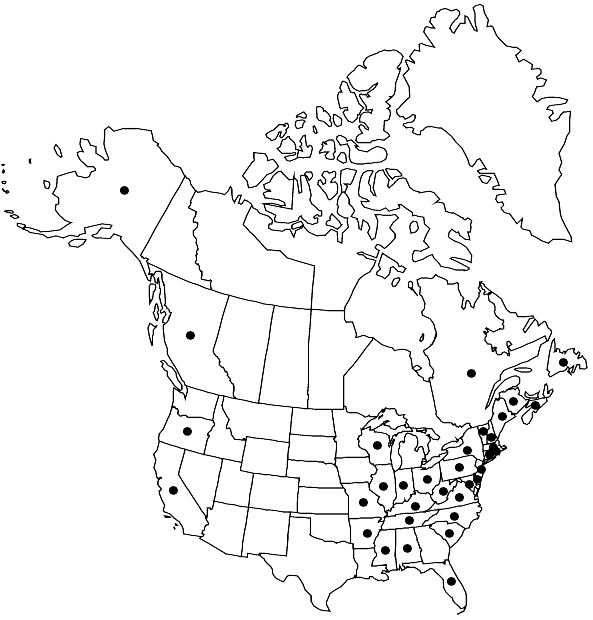Sphagnum bartlettianum
in H. G. A. Engler, Pflanzenr. 51[III]: 105. 1911,.
Plants ± moderate-sized, capitula flat-topped and stellate to some-what hemispherical; variegated pale yellowish and red, sometimes partially green or completely red; without metallic lustre when dry. Stems pale yellow to red; superficial cortical cells aporose. Stem leaves narrowly lingulate-triangular, 1.2–1.8 mm, apex acute to apiculate, border not developed much along margins and narrow at base (occupying less than 0.25 the width of the base); hyaline cells rhombic, mostly 0–1-septate. Branches usually strongly 5-ranked. Branch fascicles with 2 spreading and 1–2 pendent branches. Branch leaves narrowly ovate-lanceolate, 1.2–1.5 mm, concave, straight, apex strongly involute, border entire, hyaline cells on convex surface with 3–9 faintly ringed rounded-elliptic pores along the commissures often quite small apically, largely aporose on concave surface. Sexual condition dioicous. Spores 19–28 µm; coarsely papillose on both surfaces with a distinct ridged border around perimeter of proximal surface; proximal laesura less than 0.5 spore radius.
Phenology: Capsules mature late spring to early summer.
Habitat: Ecology poorly understood, more southern weakly minerotrophic sites such as the mires in the Pine Barrens of N.J. and the pocosins of the Atlantic coastal plain
Elevation: low to moderate elevations
Distribution

B.C., N.B., Nfld. and Labr. (Nfld.), N.S., Que., Ala., Alaska, Ark., Calif., Conn., Del., Fla., Ill., Ind., Ky., Maine, Md., Mass., Miss., Mo., N.H., N.J., N.Y., N.C., Ohio, Oreg., Pa., R.I., S.C., Tenn., Vt., Va., W.Va., Wis., Europe.
Discussion
Sporophytes are not common in Sphagnum bartlettianum. Confusion is most likely with S. rubellum, with which it frequently co-occurs in the northern part of its range. The ecology is poorly understood due to taxonomic confusion with S. rubellum; the latter species, however, is more typical of boreal poor fens and bogs. Sphagnum bartlettianum has a narrower stem leaf with a distinctly pointed and even apiculate tip, whereas the stem leaf on S. rubellum is quite rounded. The branch leaves of S. bartlettianum are also narrower than those of S. rubellum and are never subsecund as in the latter. Sphagnum quinquefarium has shorter and wider stem leaves as well as often having 3 spreading branches per fascicle. Sphagnum wilfii can appear quite similar and it does overlap the range of S. bartlettianum in coastal British Columbia and southeastern Alaska. Sphagnum wilfii has a stem leaf that is triangular to triangular-lingulate in contrast to the narrowly lingulate-triangular stem leaf of S. bartlettianum.
Selected References
None.